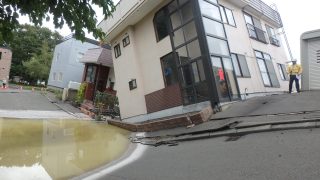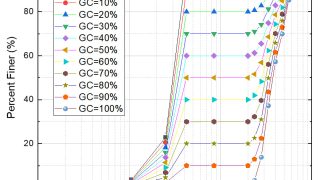地盤は単なる“土の塊”ではなく、土粒子の種類や大きさ、水の含有量、応力条件、さらには時間の経過や気候変動といったさまざまな要因が複雑に絡み合い、その強度や変形特性を刻一刻と変化させます。ときには地震動によって急激に強度を失い、流動的な挙動を示す液状化が起きたり、豪雨や干ばつが繰り返される中で地盤が脆くなったりすることもあります。
こうした自然のメカニズムを明らかにする研究では、要素試験機や振動台を用いた実験はもちろん、原位置試験やフィールド調査の知見を組み合わせながら、現場で起こっている現象を再現・分析します。たとえば、せん断波速度によって土粒子構造の影響を評価する新たな手法は、従来の常識を覆し、地盤の「年代効果」を正しく考慮した設計やリスク評価を可能にしつつあります。
このように、私たちの研究室が取り組む地盤メカニズムの解明は、単に災害時の被害を小さくするだけでなく、必要以上に強固な対策を行うことで起こりうる環境や経済への負担を軽減する意味も持っています。未知の要素が多いからこそ、自然と向き合う姿勢には常に謙虚さが求められますが、その分、新たな発見や技術開発につながる高揚感が大きな原動力となっています。
Soil is a complex assemblage of particles whose size, type, moisture content, and stress state continually shift over time and under different environmental conditions. During earthquakes, ground layers can rapidly lose strength and liquefied, while repeated cycles of heavy rain and drought may gradually weaken the soil. Our research aims to understand these dynamics by integrating laboratory experiments—using triaxial test apparatuses, shaking tables, or high-speed imaging—with field data collected from actual disaster sites.
A prime example is the development of new methods for assessing liquefaction resistance, which incorporate factors such as shear wave velocity to account for the “aging effects” in soil. Traditional evaluations sometimes underestimate or overestimate a ground’s actual strength, leading to either insufficient protection or costly over-engineering. By capturing the nuanced behavior of soil structures, we aim to create rational designs that neither neglect real risks nor impose unnecessary burdens on the environment or the economy.
In tackling these mechanisms, humility is essential. Nature’s complexity can reveal surprising insights, overturning prior assumptions about ground strength or slope stability. However, it is precisely this abundance of unknowns that drives our sense of discovery. Each breakthrough in understanding soil behavior paves the way for more accurate hazard maps, better engineering standards, and ultimately more sustainable communities that respect both human needs and the natural environment.




















